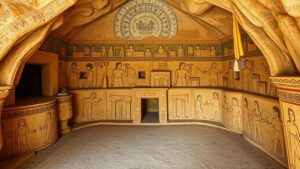The hunt for a hidden chamber beneath the Sphinx: truth or legend?
The Hunt for a Hidden Chamber Beneath the Sphinx: Truth or Legend?
The Great Sphinx of Giza, an iconic symbol of ancient Egypt, has fascinated historians, archaeologists, and enthusiasts for centuries. Its enigmatic structure, combined with the allure of buried secrets, has sparked numerous theories about a hidden chamber beneath its massive limestone paws. This article delves into the ongoing exploration of these hidden depths–examining both the factual basis and the myths surrounding the potential chamber.
Historical Background of the Sphinx
Constructed during the reign of Pharaoh Khafre around 2500 BC, the Great Sphinx measures 73 meters long and 20 meters high, making it the largest monolithic statue in the world. Located on the Giza Plateau, its purpose remains a subject of debate; however, it is widely believed to serve as a guardian of the nearby pyramids. According to ancient texts, the Sphinx was revered as a divine figure embodying strength and protection.
The Legend of Hidden Chambers
The idea of hidden chambers beneath the Sphinx is rooted in various legends and theories. Ancient texts from Egyptian mythology suggest that the Sphinx is a repository of secret knowledge and treasures. most notable of these is the assertion that the Sphinx was built over the site of the Hall of Records, a mythical repository said to contain the history of civilization.
- The Hall of Records is often imagined as a vast library of wisdom, containing ancient texts and artifacts.
- Many researchers and enthusiasts point to Herbert Winlocks 1936 theories, which correlated the Sphinx’s alignment with various astrological observations.
Modern Investigations and Discoveries
In recent decades, scientific investigations have attempted to unearth any existing chambers beneath the Sphinx. One of the most notable explorations occurred in the 1990s when Dr. Zahi Hawass and a team from the Egyptian Supreme Council of Antiquities employed ground-penetrating radar. detected anomalies in the area around the Sphinx, suggesting the possible presence of voids.
Another significant study was conducted in 2016, when a new generation of radar technology further revealed anomalies that might indicate hidden chambers. This raised hopes among researchers eager to confirm the existence of any lost treasure or information.
Scientific Skepticism
Despite the tantalizing prospects of hidden chambers, many in the academic community urge caution. Critics argue that anomalies detected by radar could result from natural geological formations rather than man-made structures. Dr. Mark Lehner, an archaeologist who has extensively studied the Giza Plateau, emphasizes the need for rigorous, systematic excavation before drawing conclusions.
Real-World Applications and Theoretical Possibilities
The search for hidden chambers beneath the Sphinx has broader implications beyond historical curiosity. It reflects humanitys ongoing desire to understand our past and unlock ancient secrets. techniques used in this investigation–like ground-penetrating radar and 3D imaging–also find applications in modern archaeology and conservation efforts worldwide.
- Similar technologies have been used to discover new sites in places like Pompeii and Machu Picchu.
- Understanding historical engineering techniques can inform modern construction and restoration projects.
Conclusion and Actionable Takeaways
The hunt for a hidden chamber beneath the Great Sphinx remains an intriguing blend of truth and legend. While ongoing research continues to provide insights, the possibility of undiscovered chambers fuels curiosity and exploration in the fields of archaeology and history.
For those captivated by this mystery, here are a few actionable takeaways:
- Stay informed about ongoing archaeological findings via dedicated publications and news sources.
- Consider visiting Giza to experience the site firsthand and gain a deeper appreciation for its history.
- Engage in community discussions and forums to share insights and theories related to the Sphinx and ancient Egyptian culture.
The allure of the Sphinx continues to inspire research, prompting scholars and curious minds alike to seek answers to its many mysteries.



